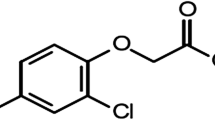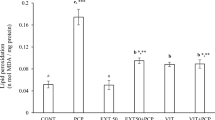Abstract
The hepatoprotective potential of earthworm extract (EE) (Lampito mauritii, Kinberg) was evaluated against paracetamol-induced liver injury in Wistar albino rat, in comparison with silymarin, the standard hepatoprotective drug. We observed a reduction in liver antioxidants, such as glutathione (GSH), superoxide dismutase (SOD), glutathione peroxidase (GPx), and catalase (CAT) and in serum total protein, and an increase in serum alkaline phosphatase (ALP), serum aspertate aminotranferase (AST), serum alanine aminotranferase (ALT), bilirubin and liver thiobarbituric acid reactive substances (TBARS) due to liver injury in the paracetamol-administered rats (2 g/kg). On the contrary, increased activities of liver GSH, SOD, GPx, CAT and serum total protein level, and decrease in the contents of serum ALP, AST, ALT, bilirubin and liver TBARS were observed in rats administered with different doses of EE (100, 200 and 300 mg/kg), which are similar to the activities of hepato-protective drug silymarin (150 mg/kg). The mode of action of EE as evidenced by the above parameters may suggest that EE, on the one hand, prevents the formation of the reactive oxygen groups, or scavenges these groups, thereby preventing the damage on the hepatic cells, and, on the other hand, modulates the genes responsible for synthesis of antioxidant enzymes such as GPx, CAT and SOD in liver tissue and decreases the serum enzymatic activities such as ALP, AST and ALT.
Similar content being viewed by others
References
Alum, J., Camhi, S., Choi, A.M., 1995. Identification of a second region upstream of the mouse heme oxygenase-1 gene that functions as a basal level and inducer dependent transcription enhancer. J. Biol. Chem., 270(20):11977–11984. [doi:10.1074/jbc.270.20.11977]
Applegate, L.A., Luscher, P., Tyrrell, R.M., 1991. Induction of heme oxygenase: A general response to oxidant stress in cultured mammalian cells. Cancer Res., 51:974–978.
Balamurugan, M., Parthasarathi, K., Cooper, E.L., Ranganathan, L.S., 2007. Earthworm paste (Lampito mauritii, Kinberg) alters inflammatory, oxidative, haematological and serum biochemical indices of inflamed rat. European Review for Medical and Pharmacological Sciences, 11(1):77–90.
Bergmeyer, H.U., Scelibe, P., Wahlefeld, A.W., 1978. Optimization of methods for aspirate aminotransferase and alanine aminotransferase. Clin. Chem., 24:58–61.
Bhar, M.K., Das, S.K., Charkraborty, A.K., Mandal, T.K., Roy, S., 2005. Hepatoprotective effect of Enliv on paracetamol-induced liver damage in broiler chicken. Indian J. Pharmacol., 37(4):257–258.
Cooper, E.L., 2005. CAM, eCAM, bioprospecting: The 21st century pyramid. Evidence-based Complementary and Alternative Medicine, 2(2):125–127. [doi:10.1093/ecam/neh094]
Crawford, D.R., 1999. Regulation of Mammalian Gene Expression by Reactive Oxygen Spicies. In: Gilbert, D., Cotton, C. (Eds.), Reactive Oxygen Species in Biological System. Plenum, New York, p.155–171.
Ellman, G.C., 1959. Tissue sulfhydryl groups. Arch. Biochem. Biophys., 82(1):70–77. [doi:10.1016/0003-9861(59)90090-6]
Gupta, M., Mazumder, U.K., Sivakumar, T., Gomathi, P., Sampathkumar, R., 2004. Antioxidant and hepatoprotective effects of Bauhinia racemosa against paracetamol and carbon tetrachloride induced liver damage in rats. IJPT, 3:12–20.
Halliwell, B., Gutteridge, J.M., 1984. Lipid peroxidation, oxygen radicals, cell damage, and antioxidant therapy. Lancet, 323(8391):1396–1397. [doi:10.1016/S0140-6736(84)91886-5]
Hrzenjak, T., Hrzenjak, M., Kasuba, V., Efenberger-Marinculic, P., Levanat, S., 1992. A new source of active compounds—earthworm tissue (Eisenia foetida, Lumbricus rubellus). Comp. Biochem. Physiol. Part A Physiol., 102(3):441–447. [doi:10.1016/0300-9629(92)90191-R]
Ismail, S.A., Pulandiran, K., Yegnanarayan, R., 1992. Anti-inflammatory activity of earthworm extracts. Soil Biol. Biochem., 24(12):1253–1254. [doi:10.1016/0038-0717(92)90102-4]
Jollow, D.J., 1980. Glutathione thresholds in reactive metabolite toxicity. Arch. Toxicol. Suppl., 3:95–110.
Kakkar, P., Das, B., Viswanathan, P.N., 1984. A modified spectroscopic assay of superoxide dismutase. Indian J. Biochem. Biophys., 21:130–132.
King, E.J., Armstrong, A.R., 1934. Determination of serum and bile phosphatase activity. J. Can. Med. Assoc., 31:376–379.
Leeuwenburgh, C., Ji, L.L., 1995. Glutathione depletion in rested and exercised mice: Biochemical consequence and adaptation. Arch. Biochem. Biophys., 316(2):941–949. [doi:10.1006/abbi.1995.1125]
Lowry, O.H., Rose Brough, M.J., Farr, A.L., Randall, R.J., 1951. Protein measurement with Folin-phenol reagent. J. Biol. Chem., 193:265–275.
Malloy, H.J., Evelyn, K.A., 1937. The determination of bilirubin with the photoelectric colorimeter. J. Biol. Chem., 119:481–490.
Moss, D.W., Butterworth, P.J., 1974. Enzymology and Medicine. Pitman Medical, London, p.139.
Muriel, P., Garciapina, T., Perez-Alvarez, V., Murelle, M., 1992. Silymarin protect against paracetamol-induced lipid peroxidation and liver damage. Drug Chem. Toxicol., 1:163–171.
Niehans, W.G., Samuelsson, D., 1968. Formation of malondialdehyde from phospholipids arrachidonate during microsomal lipid peroxidation. Eur. J. Biochem., 6(1):126–130. [doi:10.1111/j.1432-1033.1968.tb00428.x]
Prakash, M., Balamurugan, M., Parthasarathi, K., Gunasekaran, G., Cooper, E.L., Ranganathan, L.S., 2007. Anti-ulceral and anti-oxidative properties of “earthworm paste” of Lampito mauritii (Kinberg) on Rattus Norvegicus. European Review for Medical and Pharmacological Sciences, 11(1):9–15.
Ranganathan, L.S., 2006. Vermibiotechnology—from Soil Health to Human Health. Agrobios, Jodhpur, India.
Rotruck, J.T., Rope, A.L., Ganther, H.F., Swason, A.B., 1973. Selenium: Biochemical role as a component of glutathione peroxide. Science, 179(4073):588–590. [doi:10.1126/science.179.4073.588]
Sadasivan, S., Latha, P.G., Sasikumar, J.M., Rajashekaran, S., Shyamal, S., Shine, V.J., 2006. Hepatoprotective studies on Hedyotis corymbosa (L.) Lam. J. Ethnopharmacol., 106(2):245–249. [doi:10.1016/j.jep.2006.01.002]
Sallie, R., Tredgeri, J.M., Willion, R., 1991. Drugs and the liver. Biopharmaceutics and Drug Disposition, 12(4):251–259. [doi:10.1002/bdd.2510120403]
Scott, L.N.D., 1998. A review of plants used in the treatment of liver disease: Part I. Altern. Med. Rev., 3(6):410–421.
Sheila, S., Dooley, J., 1993. Diseases of the Liver and Biliary System, 9th Ed. Backwell Scientific Publications, Osney Mead, Oxford OX2 OEL, p.1–16.
Shull, S., Heintz, N.H., Periasamy, M., Manohor, M., Jansseny, M., Marsh, J.P., Mossman, B.T., 1991. Differential regulation of antioxidant enzymes in response to oxidants. J. Biol. Chem., 266:24398–24403.
Sinha, K.A., 1972. Colorimetric assay of catalase. Ann. Biochem., 47(2):389–394. [doi:10.1016/0003-2697(72)90132-7]
Stocker, R., Yamamoto, Y., McDonagh, A.F., Glazer, A.N., Ames, B.N., 1987. Bilirubin is an antioxidant of possible physiologic importance. Science, 235(4792):1043–1046. [doi:10.1126/science.3029864]
Tabassum, N., Chattervedi, S., Aggrawal, S., Ahmed, N., 2005. Hepatoprotective studies on Phyllanthus niruri paracetamol induced liver cell damage in albino mice. Experimental Medicine, 12(4):211–212.
Willianson, E.M., Okpako, D.T., Evans, F.J., 1996. Selection, Preparation and Pharmacological Evaluation of Plant Material. John Wiley, England.
Author information
Authors and Affiliations
Corresponding author
Rights and permissions
About this article
Cite this article
Balamurugan, M., Parthasarathi, K., Ranganathan, L.S. et al. Hypothetical mode of action of earthworm extract with hepatoprotective and antioxidant properties. J. Zhejiang Univ. Sci. B 9, 141–147 (2008). https://doi.org/10.1631/jzus.B0720194
Received:
Accepted:
Issue Date:
DOI: https://doi.org/10.1631/jzus.B0720194




